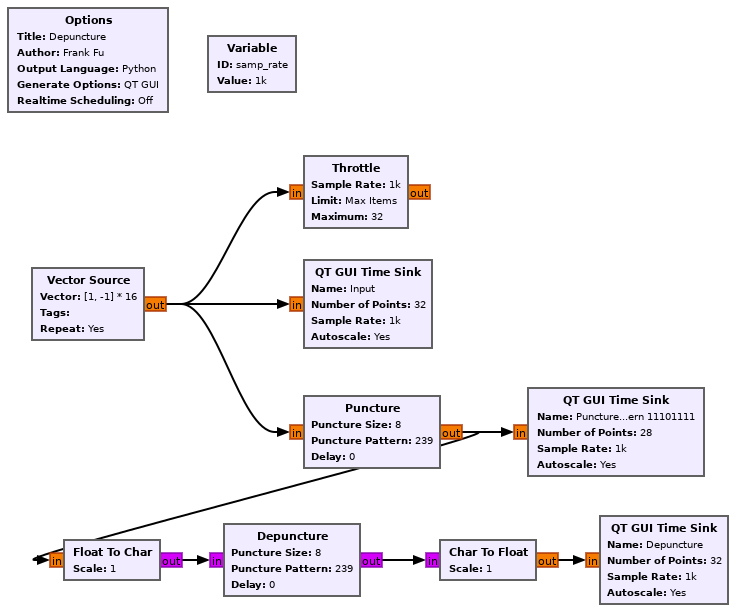Depuncture: Difference between revisions
(Created page with "Category:Block Docs Category:Stub Docs This is the template for the "Page-per-block Docs". This first section should describe what the block...") |
(add Example Flowgraph) |
||
| (2 intermediate revisions by 2 users not shown) | |||
| Line 1: | Line 1: | ||
[[Category:Block Docs]] | [[Category:Block Docs]] | ||
Depuncture a given block of input samples of . The items produced is based on the pattern. Basically, if: | |||
k = 0 | |||
if _puncpat[i] == 1: | |||
out[i] = input[k++] | |||
else: | |||
out[i] = symbol # default sym=127 | |||
This block is designed for unpacked bits - that is, every input sample is a bit, either a 1 or 0. It's possible to use packed bits as symbols, but the depuncturing will be done on the symbol level, not the bit level. | |||
puncpat is specified as a 32-bit integer that we can convert into the vector _puncpat used in the algorithm above: | |||
_puncpat = [0,...] | |||
for i in puncsize: | |||
_puncpat[i] = puncpat >> (puncsize-1-i) | |||
Example: | |||
puncsize = 8 | |||
puncpat = 0xEF --> [1,1,1,0,1,1,1,1] | |||
input = [a, b, c, d, e, f, g, h] | |||
output = [a, b, c, 127, e, f, g, h] | |||
The gr.fec Python module provides a read_bitlist function that can turn a string of a puncture pattern into the correct integer form. The pattern of 0xEF could be specified as fec.readbitlist("11101111"). Also, this allows us to use puncsize=len("11101111") to make sure that our sizes are set up correctly for the pattern we want. | |||
The fec.extended_decoder takes in the puncture pattern directly as a string and uses the readbitlist inside to do the conversion. | |||
The parameter delays the application of the puncture pattern. This is equivalent to circularly rotating the by . Note that because of the circular shift, the delay should be between 0 and , but this is not enforced; the effective delay will simply be mod . A negative value here is ignored. | |||
== Parameters == | == Parameters == | ||
; Puncture Size | |||
: Size of block of bits to puncture | |||
; Puncture Pattern | |||
: The puncturing pattern | |||
; | ; Delay | ||
: | : Delayed the puncturing pattern by shifting it | ||
; | ; Symbol | ||
: | : The symbol to reinsert into the stream (def=127) | ||
== Example Flowgraph == | == Example Flowgraph == | ||
[[File:Depuncture_fg.png]] | |||
<p>This flowgraph can be downloaded from [[Media:Depuncture.grc]].</p> | |||
== Source Files == | == Source Files == | ||
Latest revision as of 14:06, 8 May 2025
Depuncture a given block of input samples of . The items produced is based on the pattern. Basically, if:
k = 0 if _puncpat[i] == 1: out[i] = input[k++] else: out[i] = symbol # default sym=127
This block is designed for unpacked bits - that is, every input sample is a bit, either a 1 or 0. It's possible to use packed bits as symbols, but the depuncturing will be done on the symbol level, not the bit level.
puncpat is specified as a 32-bit integer that we can convert into the vector _puncpat used in the algorithm above:
_puncpat = [0,...]
for i in puncsize:
_puncpat[i] = puncpat >> (puncsize-1-i)
Example:
puncsize = 8 puncpat = 0xEF --> [1,1,1,0,1,1,1,1] input = [a, b, c, d, e, f, g, h] output = [a, b, c, 127, e, f, g, h]
The gr.fec Python module provides a read_bitlist function that can turn a string of a puncture pattern into the correct integer form. The pattern of 0xEF could be specified as fec.readbitlist("11101111"). Also, this allows us to use puncsize=len("11101111") to make sure that our sizes are set up correctly for the pattern we want.
The fec.extended_decoder takes in the puncture pattern directly as a string and uses the readbitlist inside to do the conversion.
The parameter delays the application of the puncture pattern. This is equivalent to circularly rotating the by . Note that because of the circular shift, the delay should be between 0 and , but this is not enforced; the effective delay will simply be mod . A negative value here is ignored.
Parameters
- Puncture Size
- Size of block of bits to puncture
- Puncture Pattern
- The puncturing pattern
- Delay
- Delayed the puncturing pattern by shifting it
- Symbol
- The symbol to reinsert into the stream (def=127)
Example Flowgraph
This flowgraph can be downloaded from Media:Depuncture.grc.
Source Files
- C++ files
- TODO
- Header files
- TODO
- Public header files
- TODO
- Block definition
- TODO
